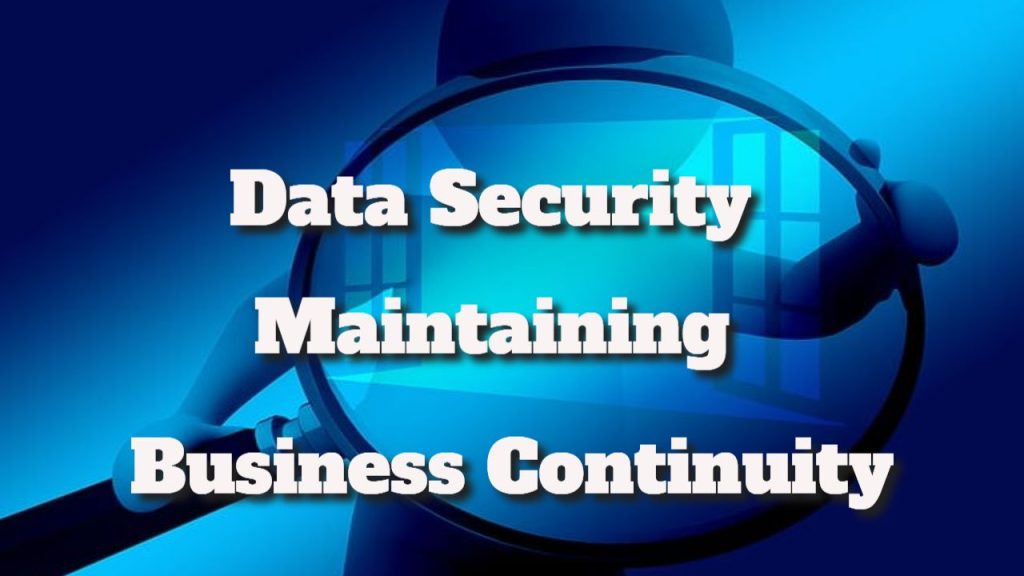Data Security Maintaining Business Continuity
Data Security Maintaining Business Continuity
Data Security Maintaining Business Continuity: In today’s tumultuous business world, when information moves at an unprecedented rate and cyber threats lurk around every corner, business continuity is more important than ever. Data protection is critical to protecting essential information assets and allowing organisations to thrive in instability and unpredictability.
We thoroughly introduce data protection and emphasise its significance in today’s volatile environment. Data protection, at its core, refers to a set of rules, processes, and technologies designed to secure sensitive data against unauthorised access, damage, or loss.
It is about solid defences against external threats like hackers and cybercriminals and internal weaknesses like staff carelessness or system breakdowns.
Companies may reduce the risks associated with data breaches, safeguard their reputation, and foster customer trust by establishing appropriate data protection procedures.
With expanding digital landscapes and increasingly sophisticated attack tactics, it is critical to grasp the various aspects of data protection.
One critical feature is confidentiality, ensuring that sensitive information is only available to authorised individuals or systems.
Access control systems and encryption techniques ensure confidentiality and stop unauthorised people from accessing networked data, databases, or cloud environments.
The preservation of data’s accuracy and consistency across time is the focus of integrity, another cornerstone of data protection. Verification systems, such as digital signatures or checksums, detect unauthorised changes or tampering attempts and, as a result, protect the integrity of critical information.
This ensures that the organisation and its stakeholders can rely on the data’s authenticity, allowing for informed decision-making and avoiding potentially disastrous repercussions.
Furthermore, availability is critical for data security, particularly in difficult times. It ensures that data and information systems are available and operating when required.
Companies build redundant infrastructure, establish backup and recovery processes, and develop contingency plans to provide ongoing access to critical data, even during disruptive events such as natural disasters, power outages, or cyber-attacks. Furthermore, data protection entails managing the data lifecycle or the treatment of data from its production to its eventual disposal.
Data is managed effectively throughout its existence thanks to proper categorisation, retention policies, and safe destruction methods.
This comprehensive strategy lowers the danger of holding unneeded or obsolete data, prevents potential regulatory violations, and streamlines data management methods, ultimately enhancing corporate productivity.
Data protection faces new issues as technology changes rapidly, necessitating ongoing adaption. With the latest technological innovations, such as AI, new security threats arise from cloud computing and the IoT. Understanding these changing ecosystems is crucial for organisations to avoid potential attacks and secure their data efficiently.
Data Security Is A Fundamental Requirement In Today’s More Unpredictable Corporate Scene.
Organisations may limit risk, preserve trust, and ensure business continuity by prioritising data confidentiality, integrity, availability, and proper data lifecycle management.
In the following parts, we will go deeper into the complexities of data protection and provide numerous tactics, best practices, and new technologies that organisations may employ to safeguard their critical data.
Stay tuned for the second half of this chapter, in which we’ll explore the changing landscape of data protection and delve into the critical concerns for data security in the face of chaos.
Organisations Must Be Prepared To Adapt To New Technologies And Manage The Complexity Of The Ever-Changing Data Protection Landscape.
This chapter’s second section examines the critical issues for securing data in times of chaos, providing significant insights and advice for organisations seeking to ensure business continuity and secure their valuable data.
Proactively detecting and mitigating vulnerabilities and threats is vital for data protection. Regular risk assessments and vulnerability scans can assist organisations in identifying gaps in their systems and networks so that security solutions can be implemented before an attack happens.
Companies that take a proactive approach to data protection can keep one step ahead of potential threats and reduce the impact of cyber events.
In data protection initiatives, the human component must be recognised. Education and training programmes are critical when preparing staff with the knowledge and skills to recognise and respond correctly to possible security threats.
It is critical to improve data protection awareness and emphasise the role of each individual in preserving the privacy, authenticity, and accessibility of critical data. Regular training, simulations of real-world circumstances, and ongoing communication can foster a business culture prioritising data security.
In addition to boosting staff knowledge, substantial access restrictions must be implemented to protect sensitive data. Thanks to role-based access controls (RBAC) and the principle of least privilege, employees only have access to the information they need to execute their tasks.
Another helpful method is the segregation of roles, in which workers are assigned to various phases of essential procedures to reduce the possibility of unauthorised access or evil behaviour. Organisations can lessen the possibility of insider threats and limit the impact in the event of a breach by adopting stringent access controls.
A solid data protection strategy must include backup and recovery options. Backing up critical data regularly and keeping it in secure locations or through cloud-based solutions guarantees that organisations can recover rapidly in the event of data loss or system failure.
Off-site backups safeguard against physical damage, theft, and natural calamities. Backup and recovery operations must be tested regularly to ensure dependability and minimise downtime.
Another critical part of data security is the use of robust encryption algorithms. Encryption turns data into unreadable formats, rendering it useless to unauthorised persons even if it is accessible.
Encrypting data at rest, in transit, and in use can help businesses limit unauthorised access or interception risks.
Protecting the privacy and integrity of sensitive information requires employing robust encryption methods and keeping encryption keys secret.
Modern data security measures must adapt to new technology like the IoT, cloud computing, and artificial intelligence (AI). Artificial intelligence-powered threat detection and response systems can assist organisations in identifying and mitigating potential security risks in real-time.
Cloud-Based Solutions Provide Greater Scalability, Data Redundancy, And Integrated Security.
Organisations must be cautious when selecting cloud service providers to handle potential security and privacy problems.
Continuous monitoring and incident response are critical components of an adequate data protection plan. Monitoring networks, systems, and user activity allows instant anomalies or suspect behaviour detection.
Rapid incident response and investigation enable businesses to analyse the impact of a suspected security breach and take rapid action to limit and mitigate the harm.
To mitigate the impact of cyber incidents, it is critical to establish an incident response team, formalise response protocols, and perform regular drills.
To summarise, data protection is a continual endeavour that necessitates a thorough grasp of the changing context and the deployment of proactive measures.
Organisations will be better equipped to ensure business continuity and protect their valuable information assets if they consider the elements discussed in this chapter, which include identifying vulnerabilities and threats, training employees, implementing strong access controls, backup and recovery mechanisms, encryption techniques, and adapting to new technologies.
In today’s tumultuous corporate world, data protection is not a one-time event but a continuing commitment to limiting risk and sustaining confidence.
Putting In Place A Solid Data Security Framework
Organisations have various issues preserving important data in today’s continuously changing and linked environment. With the development of cyber threats, natural disasters, and unplanned disruptions, it is critical to ensure the security and continuity of corporate operations.
This chapter explains the critical steps for developing an effective data security architecture to safeguard sensitive data during disruption.
1. Evaluate Vulnerabilities And Risks
Before implementing data security measures, it is necessary to conduct a thorough vulnerability and risk assessment. This includes identifying potential internal and external data security, integrity, and availability threats. Once the risks to an organisation are identified, relevant and targeted protective measures can be implemented.
2. Access Controls Are Defined As Follows:
To safeguard data from unauthorised access, substantial access restrictions must be implemented. This includes defining user roles and permissions, implementing robust authentication techniques like multi-factor authentication, and regularly evaluating and upgrading access authorisations. To lessen the likelihood of data breaches, ensure only approved individuals can access sensitive information.
3. Cryptography Implementation:
Encryption is a robust technique for preventing unauthorised data access, particularly when transporting or storing data. Encryption converts data into ciphertext, rendering it unintelligible to unauthorised persons without a decryption key. Robust encryption methods and safe critical management practices are vital for protecting data security even in turbulent environments.
4. Data Security:
Regular data backups are vital to any data security strategy in the face of chaos and interruption. Organisations may maintain data availability even during ransomware attacks, hardware failures, or natural catastrophes by making multiple copies of vital data. To improve reliability and accessibility, backup data should be stored in secure off-site locations or cloud-based storage solutions.
5. Create Incident Response Procedures:
Incidents can occur regardless of how robust the data security framework is. As a result, organisations must have a well-defined incident response plan to limit potential damage successfully. This plan should include specified communication routes, response teams, and methods to contain and recover from data breaches or other security incidents. Testing and updating incident response processes regularly is critical to ensure their efficacy.
6. Programmes For Education And Awareness:
Data security is a shared responsibility, and employees play an essential role in safeguarding sensitive information. Companies should engage in thorough training and awareness programmes to educate their staff on best practices for security, potential dangers, and how to respond to security crises. Organisations can build resilience to chaotic circumstances by creating a strong security culture.
Threats to data security are continually growing as society relies more on technology and data. Developing a solid data security strategy is essential for organisations to maintain business continuity in times of upheaval.
The first half of this chapter covered the critical stages involved in developing such a framework, such as vulnerability assessments, access controls, encryption, data backups, incident response procedures, and staff training.
By taking these steps, organisations can better protect sensitive data and limit the dangers of chaotic environments.
Putting Robust Data Security Mechanisms In Place
After discussing the crucial steps in developing a solid data security architecture in the face of chaos, this chapter will focus on the remaining vital measures organisations should consider.
By employing these strategies, businesses can enhance their capacity to safeguard confidential data and keep operations running smoothly even when uncertain.
7. Frequent Monitoring And Auditing:
A robust data security system requires continuous monitoring and auditing to detect unauthorised activity or potential vulnerabilities.
Organisations can quickly discover and address security breaches or vulnerabilities using reliable monitoring tools and frequent audits.
This proactive strategy allows for timely repair, preventing threats from recurring and minimising the possible impact on corporate operations.
8. Data Loss Prevention
(DLP) solutions are crucial in securing sensitive information by monitoring and controlling data flow to prevent unauthorised access, storage, or transmission of sensitive data.
These technologies detect possible data breaches and implement the appropriate preventative actions by combining established policies, content inspection, and user behaviour analysis.
Organisations may minimise the risk of data breaches and assure the protection of sensitive information by using DLP solutions.
9 Build Secure Network Perimeters:
Organisations must build secure network perimeters To protect themselves from external threats in an interconnected environment. Putting an intrusion detection and prevention system in place, firewalls, and robust network segmentation techniques aids in the isolation of sensitive data and the reduction of the attack surface.
Organisations can reduce the likelihood of unauthorised access and establish a more robust defence against potential threats by ensuring that only authorised connections can access internal network resources.
10. Regular Vulnerability Assessments And Penetration Tests:
To stay safe, businesses should regularly check for vulnerabilities and do penetration tests. These tests reveal network, system, and application vulnerabilities, allowing organisations to remedy them before exploiting them.
Organisations can uncover weaknesses and take the necessary actions to strengthen their defences by mimicking real-world attacks via penetration testing.
11. Adherence To Best Practices And Industry Standards:
Organisations should stay current on best practices and industry standards for data security. These frameworks, such as ISO 27001 or the NIST, ensure that sensitive information remains secure, intact, and available and a cybersecurity framework is implemented.
This framework includes rules and extensive controls. Compliance with these standards reflects an organisation’s commitment to data security and aids in implementing effective security procedures that align with industry expectations.
12. Continuous Education And Skill Development:
Data security is dynamic, and keeping up with new threats necessitates ongoing education and skill development. Companies should encourage a culture of continual learning by giving staff access to relevant training, industry conferences, and certifications.
Employees equipped with current information and skills will be better able to adopt robust security measures and play a more active role as frontline defenders against data breaches.
By applying these additional steps, businesses can strengthen their data security framework and develop a resilient defence against chaos-induced disruptions.
However, it is critical to remember that data security is a continuous process rather than a one-time occurrence.
Maintaining good data security requires regular inspections, updates, and adjustments to new threats and technological breakthroughs.
A proactive approach to data security safeguards sensitive information improves an organisation’s reputation, fosters stakeholder trust, and may lessen legal and financial risks connected with data breaches.
The ability of an organisation to adequately safeguard and recover its digital assets in the face of turmoil is essential to ensuring continued company operations and long-term success.
Finally, this chapter has covered the critical elements for building a solid data security system.
Organisations can increase their resistance to chaotic events by analysing vulnerabilities and threats, adopting access controls, installing encryption, backing up data, establishing incident response protocols, and conducting training and awareness programmes.
Organisations may tackle the difficulties of an increasingly connected world while guaranteeing the security and continuity of their business operations by applying the principles presented in this chapter.

Protecting Data To Ensure Company Continuity
In today’s fast-changing technological landscape, where organisations rely heavily on data, providing uninterrupted business continuity has emerged as a significant problem.
Organisations must implement robust procedures to protect sensitive data while maintaining operational efficiency because of the rising frequency and sophistication of cyber-attacks and the possibility of natural catastrophes and other unanticipated interruptions.
To overcome these difficulties, organisations must incorporate data protection measures into their overall continuity planning. Doing so can lessen the blow of unforeseen circumstances and ensure their operations run smoothly.
We Examine Strategies And Best Practices For Ensuring Business Continuity Through Data Protection.
Adopting appropriate backup and recovery solutions is critical to data security and business continuity planning. Backups stored securely off-site or in the cloud regularly can lessen the risk of data loss in the case of an electrical outage, cyberattack, or catastrophic weather occurrence.
Organisations should adopt clearly defined backup policies and procedures to guarantee that critical data is often secure and can be swiftly restored if disaster strikes.
Organisations should consider having effective data recovery mechanisms in addition to backups. This includes assessing the effectiveness of backup systems regularly and ensuring that data can be recovered appropriately.
Regular data recovery exercises can provide significant insight into data security infrastructure gaps and vulnerabilities, allowing organisations to refine their plans and proactively resolve problems.
Another critical part of assuring company continuity through data protection is data encryption. Encryption turns data into an unreadable state, severely limiting the ability of unauthorised individuals to access or abuse the data.
Employing robust encryption algorithms and adhering to encryption best practices can help organisations protect sensitive data and reduce the risk of data breaches.
Furthermore, organisations should be proactive in data security by implementing substantial access restrictions and authentication procedures.
This ensures that only authorised workers can access sensitive data, reducing the likelihood of internal data breaches.
Implementing multi-factor authentication, role-based access controls, and frequent employee security training can dramatically improve data protection and improve an organisation’s overall resilience.
Another critical factor in ensuring business continuity is the development of appropriate contingency and recovery plans.
These plans should include specific policies and processes for dealing with data breaches, cyber-attacks, and other disruptions. Testing and updating these plans regularly is vital to maintain their effectiveness and relevance in the face of new threats.
Organisations can considerably increase their ability to resist disruptions and sustain smooth operations by incorporating data protection measures into their overall continuity planning. In the second half of this chapter, we’ll look more closely at specific tools and technologies that might assist organisations in achieving robust data protection and business continuity.
Building data protection frameworks, employing cutting-edge technologies, and utilising data backups to ensure continued business operations and avoid turmoil.
These tools and technologies are critical in the face of escalating cyber threats and unanticipated interruptions. By employing these steps, organisations can ensure ongoing business operations and protect themselves against turmoil.
Advanced threat detection and defence systems are critical for data security and business continuity. These systems employ AI and ML algorithms to identify and counteract any security vulnerabilities as they happen.
By constantly scanning network traffic and studying patterns, these systems can identify dangers before they do serious harm and react accordingly. Companies should consider investing in these tools to identify better, prevent, and mitigate cyberattacks.
Organisations should install intrusion detection and prevention systems (IDPS) to supplement threat detection and prevention systems. These systems monitor network traffic, detect unauthorised access attempts, and block or terminate suspicious activity.
Companies can use IDPS to protect their data and avoid any security breaches. These systems must be updated regularly to ensure their effectiveness against evolving cyber threats.
Organisations should use secure cloud storage solutions in addition to advanced threat detection and defence systems. Cloud-based data storage has various advantages regarding data security and business continuity.
It enables businesses to grow storage capacity as needed while ensuring that critical data is always safely backed up. Cloud storage also reduces the danger of physical device failure or damage because data is saved and copied across numerous servers.
In the case of a disaster or cyber-attack, this redundancy boosts data resilience and facilitates speedy data recovery.
Organisations should implement robust encryption technologies to preserve data integrity and secrecy. Data encryption techniques turn data into unreadable formats, rendering it useless to unauthorised outsiders.
Adopting industry-standard encryption algorithms, such as Advanced Encryption Standard (AES), protects the security of sensitive data throughout storage and transmission.
To defend against potential vulnerabilities, encryption must be applied at all levels of data, including databases, file systems, and communication routes.
Furthermore, organisations should regularly monitor and review their data protection and business continuity strategies. Conducting vulnerability assessments and penetration tests to discover potential gaps in the data protection architecture is part of this.
Organisations may keep one step ahead of cyber threats and assure the success of their data protection plans by periodically assessing and enhancing security procedures.
Finally, organisations must define their roles and responsibilities for data security and business continuity. Dedicating workers to monitor and manage these measures can dramatically improve the organisation’s ability to respond to disturbances.
Employees should be informed of their roles and responsibilities in preserving data security through regular training and awareness programmes.
This ensures that everyone in the company understands the importance of protecting the availability and authenticity of vital records.
Preserving business continuity through data protection necessitates a multi-layered strategy.
Organisations may increase their ability to withstand disruption and protect against chaos by using advanced threat detection and defence systems, secure cloud storage solutions, robust encryption techniques, and regular monitoring and auditing.
Furthermore, creating clear roles and responsibilities and implementing frequent training programmes will aid in the development of a data security and resilience culture.
With these safeguards, businesses may efficiently negotiate the challenges of a fast-expanding digital world while maintaining uninterrupted business operations.





